 Like a lot of people, the historians at IHB are working from home. We’re feeling very lucky to be healthy and employed, as we know not everyone is so fortunate. As usual, we’re trying to find historical stories that will be of interest, and hopefully useful, to our fellow Hoosiers in these strange times in which we find ourselves.
Like a lot of people, the historians at IHB are working from home. We’re feeling very lucky to be healthy and employed, as we know not everyone is so fortunate. As usual, we’re trying to find historical stories that will be of interest, and hopefully useful, to our fellow Hoosiers in these strange times in which we find ourselves.
Since Hoosiers across the state are stuck at home, let’s try some new things in the garden. And who better to look to for advice than the generations of Hoosiers who came before us? So let’s see what we can do with just a few supplies and perhaps an order of heirloom seeds. You can find heirloom seeds from small companies like Baker Creek Heirloom Seeds that are attempting to keep rare seeds with long histories in circulation. They’re closed until Monday, March 23 to make sure they’re completely disinfected and their employees are healthy. That gives us time to look through historical newspapers for gardening wisdom from experts in the past. A great resource is the early-20th century column titled, “Of Interest to the Farmers and Gardeners” in the Indianapolis News. It’s so packed full of advice, it’s hard to know where to begin. So here are just a few ideas from March articles about early spring planting.
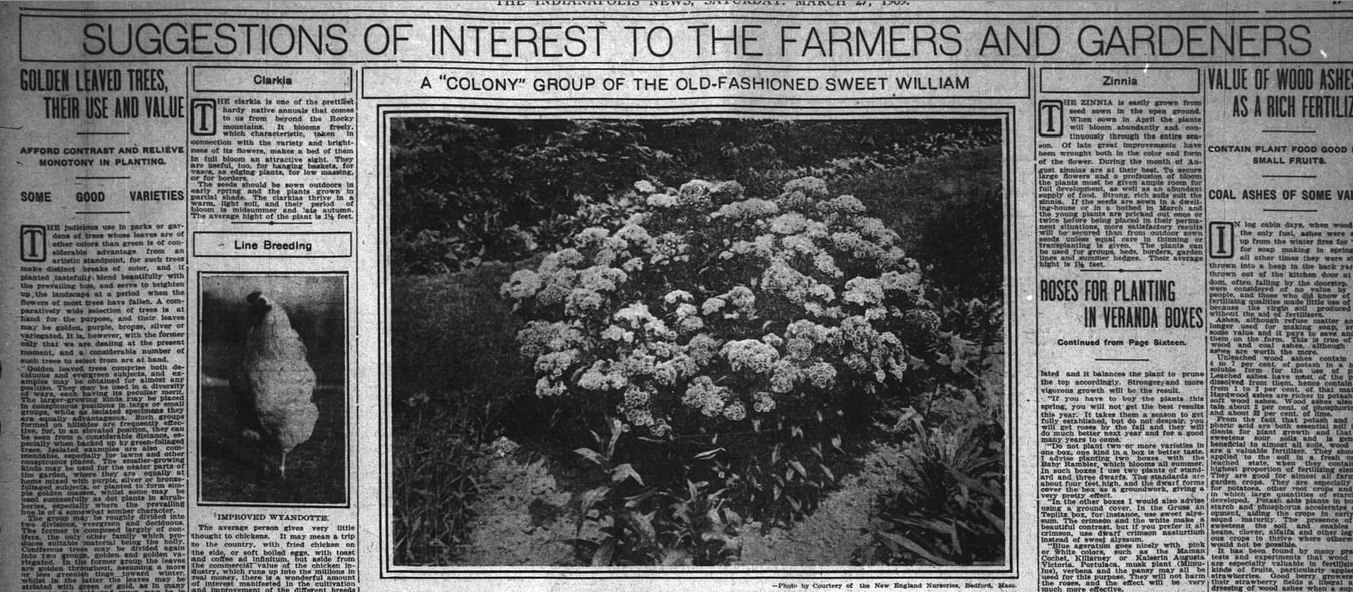
Hotbeds and Cold Frames
A March 1909 Indianapolis News column warned:
The amateur gardener who wants to keep abreast of his neighbors when warm weather comes had better prepare his hotbed of boxes at once.
Well, okay then. The March 19, 1910 Indianapolis News explained the advantages of both hot beds and cold frames and how they work. Checking the information against a recent article on the subject from the Department of Horticulture and Landscape Architecture of the Purdue University Extension, the historical paper’s advice really holds up.

Hotbeds and cold frames are built the same: a frame set into the ground with a glass panel to cover the plants. While there is a lot of advice about how to tweak each design, the heat source is the only real difference. These instructions from Purdue University give all the necessary details. But they’re both ways to get a jump on the growing season in the spring or extend it in the fall.
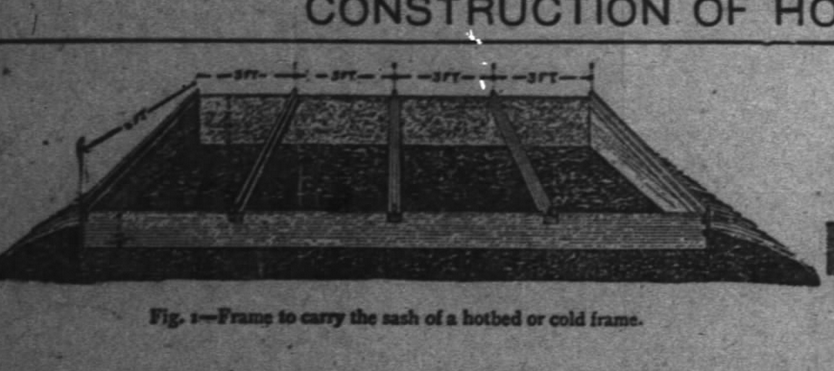
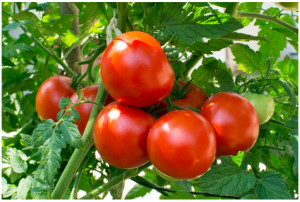
As the 1910 Indianapolis News explained, the hotbed is supplied with heat, usually from fermenting manure, but there are other options (see the sweet pea section below). The News suggested placing the bed not in the garden, but by a path or building “where it can receive attention without interfering with other work.” The 1910 columnist stated that it should always face south with the south side of a building or hedge providing protection. The hotbed should be started in March if growing tomatoes and cabbages, so they are ready to plant in the garden in April. If the night gets really cold, cover the glass panel with “board shutters, straw mats, or mats of burlap or carpet,” and if it gets too hot in the day, raise the panels to ventilate the plants. The News advised, “Hotbeds should be watered in the morning only and then only on bright days.” This avoids losing heated air by opening the panel too often, lowering the temperature too much, or making the soil too damp.
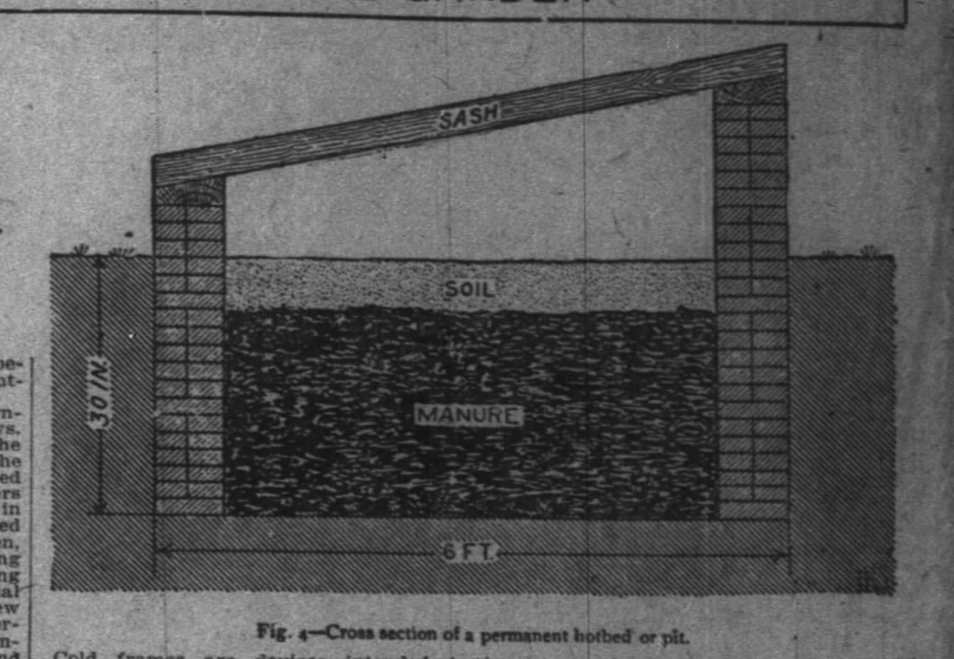

The same Indianapolis News article also explained:
Cold frames are devices intended to protect plants from cold, without forcing them to growth. They differ from hotbeds in that no artificial means of heating are employed.
Likewise, the Purdue Extension explains that plants grow slower in cold frames, which is great for lettuce and spinach. The Old Farmer’s Almanac recommends cold frames for greens as well as radishes, scallions, kale, and endive. They also have a step by step guide to building a cold frame.
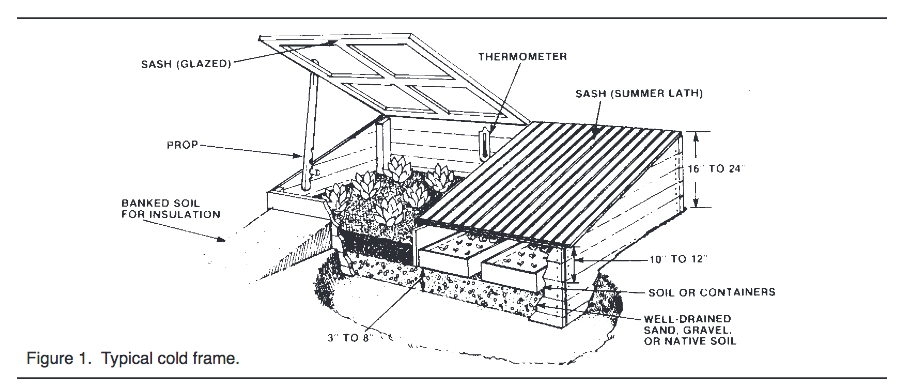
Starting Seeds Indoors
Of course, not everyone has the resources to build frames. The March 27, 1909 Indianapolis News has advice for simpler starts as well:
The simpler method of raising plants to be set out after danger of frost is over is to sow seed in boxes or pots to be kept indoors. The boxes should have holes for drainage in the bottom, but should not be so open as to let the soil dry.
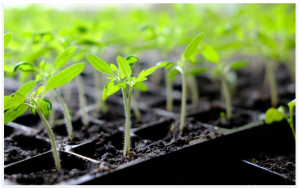
I use the plastic flats from my previous year garden store purchases. Right now my kitchen table is covered and I have native wildflowers just starting to sprout. They’re doing much better this year than the ones I started last year because I carefully mixed peat, potting soil, and pearlite and have misted them regularly. The News recommended a light mix like this for the top soil when planting in boxes but noted that regular garden soil would be fine beneath that. The 1909 gardener advised small seeds be sown over the surface and gently pressed down while “coarse seeds” needed to be dropped into little holes and covered. Water both immediately after planting and set boxes where they will get indirect sunlight, not harsh rays. And finally, the Indianapolis News gave some advice on a flower you can start right in the garden this month.
Sowing Sweet Pea Seeds

Annual sweet peas have a wonderful, unforgettable scent. The perennial version has no scent and can be invasive, so choose wisely. Try heirloom varieties like the 1896 “America” or the ca. 1901 “Old Spice.” Sweet peas like cold weather, so they’re a great plant to start in the early spring. In March 1911, the Indianapolis News gave the perfect recipe for rich soil to grow this delicate flower. The newspaper’s advice for a “rich and deep” soil that would create “plenty of blooms of good substance” was to add “plenty of well-rotted manure.” Of course, those of us without access to manure (or without the desire to have access) can use rotted grass clippings , leaves, vegetable kitchen scraps, coffee grounds, or a mix of these items. The Farmer’s Almanac gives a rundown of the benefits of each mix and its own tips for growing sweet peas.
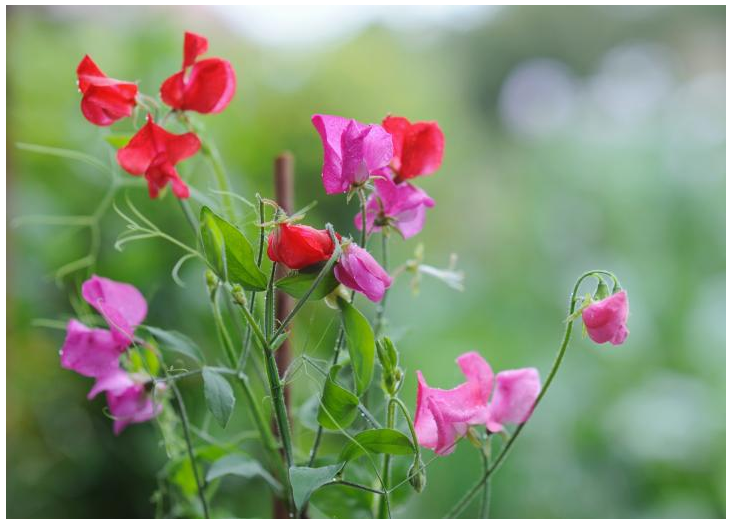
The 1911 Indianapolis News recommended you sow seeds directly outdoors (as opposed to starting indoors) while weather is still cold between mid-March and mid-April. The article continued:
Make a trench or furrow about six inches deep, in the bottom of which sow the seed thickly. Cover the seed with about an inch of soil, pressing it down firmly. As soon as they are above ground, thin out to two or four inches apart; when planted too close they do not attain their full development. As soon as the plants are above the trench the balance of the soil may be filled in.
Before they mature, add stakes with wire netting or even branches, that are at least four feet high. Adding mulch at the start of the summer will help them get through the hot weather.
We hope you’re finding productive ways to spend your time while at home, whether you experiment with heirloom plants or not. Check in with IHB on Twitter (@in_bureau) or Facebook and let us know what history questions you have. And check back in April for more historical gardening wisdom from old newspapers. Finally, here’s a stanza from a relevant James Whitcomb Riley poem, for all of us itching to “git back” into the garden this weekend.
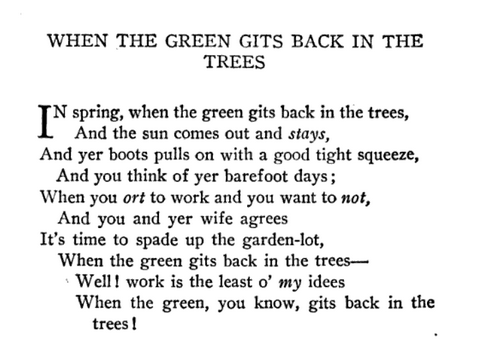
Sources
All newspapers accessed Newspapers.com.
Hotbeds and Cold Frames:
Boeckmann, Catherine. “How to Build a Cold Frame,” Old Farmer’s Almanac, https://www.almanac.com/content/how-build-cold-frame.
Dana, Michael N. and B. Rosie Lerner.”Hotbeds and Cold Frames,” Department of Horticulture and Landscape Architecture, Purdue University Extension Service, https://www.hort.purdue.edu/hort/ext/Pubs/HO/HO_053.pdf.
“Construction of Hot Beds and Cold Frames for the Growth of Early Plants to Transplant to the Garden,” Indianapolis News, March 19, 1910, 28.
Starting Seeds Indoors:
Boeckmann, Catherine. “Starting Seeds Indoors,” Old Farmer’s Almanac, https://www.almanac.com/content/starting-seeds-indoors.
“Starting Seeds Indoors to Gain a Month in the Garden When Danger of Frost Is Over,” Indianapolis News, March 27, 1909, 17.
Sweet Peas:
Andrews, Moya. “Invasive Sweet Pea,” Focus on Flowers, https://indianapublicmedia.org/focusonflowers/invasive-sweet-pea.php.
Boeckmann, Catherine. “Growing Sweet Peas,” Old Farmer’s Almanac, https://www.almanac.com/plant/sweet-peas.
“Prepare Beds for Sowing of Sweet Pea Seeds,” Indianapolis News, March 11, 1911, 18.
